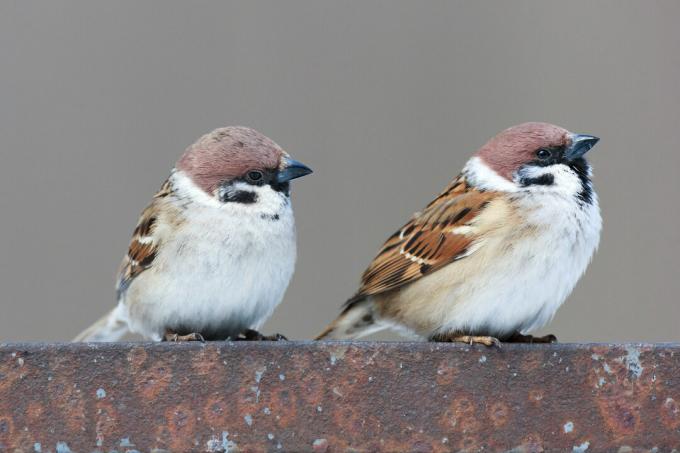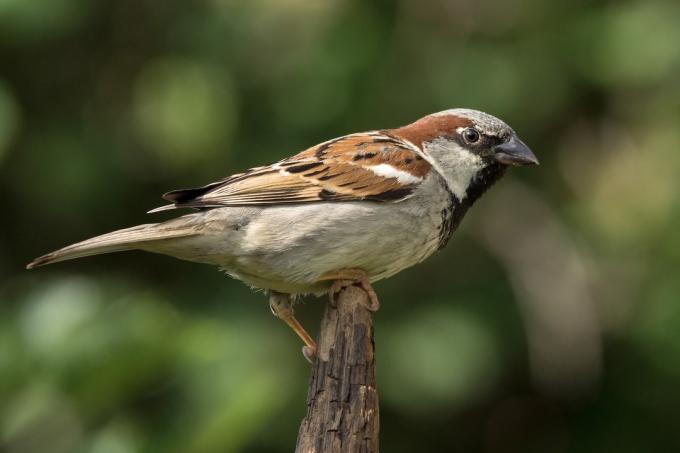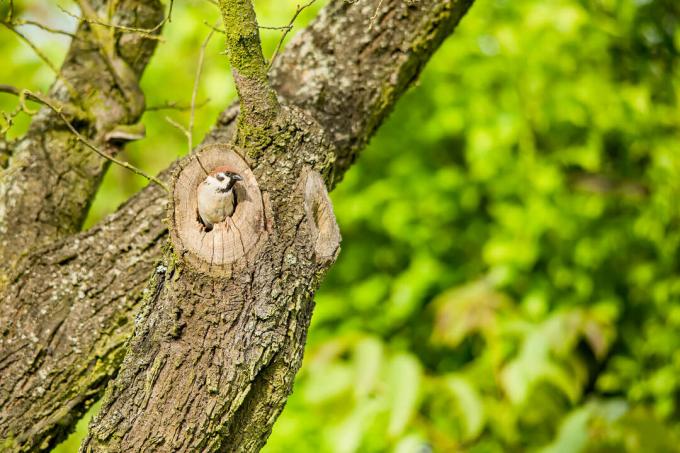What do female tree sparrows look like, like young tree sparrows? And how can you tell the difference between house sparrows and tree sparrows? You can find out everything you need to know in our profile.

Even if sparrows are generally among the best-known songbirds, very few people know that the term “sparrow” actually includes two species. In addition to that often found in cities and settlements House sparrow (Passer domesticus) there is also the somewhat shy and rarer tree sparrow (Passer montanus). The tree sparrow is quite susceptible to disturbances and therefore suffers from the increasing industrialization of agriculture. The field sparrow used to be known as a pest because its predilection for grain made it difficult for humans to harvest, it has become so rare today that it is now on the pre-warning list in the red list of Germany's breeding birds will. You can find out how you can clearly recognize the field sparrow, differentiate it from the house sparrow and support it in our large field sparrow profile.
contents
- Tree sparrows: profile
-
This is how you recognize the tree sparrow
- How do house sparrows differ from tree sparrows?
- What does the tree sparrow singing sound like?
- How do you recognize a young tree sparrow?
- How do you recognize tree sparrow eggs?
- Which habitat does the field sparrow prefer?
- Where does the tree sparrow build its nest?
- When does the tree sparrow breed?
- Where does the Feldspatz spend the winter?
-
Support tree sparrows: This is how it works
- What does the field sparrow eat?
- Which nest boxes are suitable for tree sparrows?
- How can you give the tree sparrow additional support?
Tree sparrows: profile
| size | About 14 cm |
| weight | Up to 25 g |
| Breeding season | April - July |
| lifespan | Up to 8 years |
| habitat | Semi-open landscapes, forest edges, agricultural areas |
| food | Seeds and buds, aphids and other insects |
| Threats | Loss of habitat, disturbance from agricultural machinery |
This is how you recognize the tree sparrow
The tree sparrow is characterized by brown-black striped wing covers and a uniformly gray underside. His head is adorned with a chocolate-brown cap, while his gleaming white feathers on the face are interrupted by a black throat patch and also black cheek patches. Tree sparrow females and males cannot be distinguished from one another purely visually.
How do house sparrows differ from tree sparrows?
House and field sparrows share the same brown-black plumage pattern and gray belly. The differences can be found in the head region. While the tree sparrow has a rust-brown cap, that of the house sparrow is gray. The cheeks of the house sparrow are also gray and monochrome - the dark spots on the cheek of the field sparrow, framed by snow-white feathers, are missing.

What does the tree sparrow singing sound like?
The tree sparrow has a rather monotonous song, which consists of an endlessly repeating "chelp". The chirping is very similar to the bird's voice of the house sparrow, which, however, sounds a bit higher and friendlier than that of the field sparrow.
In the following recording you can experience what the song of the tree sparrow sounds like:
How do you recognize a young tree sparrow?
Young tree sparrows are already clearly recognizable as such - with their brown-black wings, gray belly, dark cap and the indicated throat patch. However, the cap of the young birds is not yet as beautifully rust-brown as that of the adult birds, but a slightly dirty gray-brown. In addition, the typical cheek marks are missing in the young birds.

How do you recognize tree sparrow eggs?
The eggs of the tree sparrow are about 2 cm in size, pale gray in color and very densely decorated with fine, brown spots that pile up on the blunt pole of the egg. The female lays between four and six eggs per clutch in a nest made of leaves and twigs, which is padded with fine hair and feathers.
Which habitat does the field sparrow prefer?
Tree sparrows love semi-open landscapes, forest edges and settlements with attached agricultural fields. On the one hand you need open meadows and fields where you can look for grains and on the other hand you need old trees with caves in which you can raise your offspring.
Where does the tree sparrow build its nest?
As cave breeders, field sparrows prefer natural tree hollows, crevices in the wall or other cave-like structures. Nest boxes in parks or gardens are also gladly accepted. Good nesting sites are often used for several years in a row. Tree sparrows are also very social birds. They usually breed in loose colony groups, which can consist of up to 50 breeding pairs, and are also happy to be in smaller and larger groups outside of the breeding season.

When does the tree sparrow breed?
Tree sparrows are extremely monogamous animals. Once a couple has found each other, they remain true to each other for a lifetime. The breeding season of the field sparrows begins in April and, depending on the number of broods, can extend into July. During this period, up to three broods per pair are possible. After an incubation period of up to 14 days, the little chicks hatch, which are born blind and featherless as so-called nestlings. Only after a development period of up to 20 days, in which the little ones are provided with food by their parents around the clock, do the little field sparrows leave the nest. After that, the male feeds them for a while while the female prepares the next brood.
Where does the Feldspatz spend the winter?
Our native tree sparrows spend the winter in their breeding areas and therefore do not flee to the south. The sparrows can therefore be observed all year round in loose flocks foraging in fields and meadows. At the bird feeder it is also worth unpacking the binoculars in order to spot one or two field sparrows among the house sparrows that are often present.

Support tree sparrows: This is how it works
The tree sparrows, which have now become very rare, depend on our support. In the following sections you will find out how you can transform your garden into a paradise for sparrows.
What does the field sparrow eat?
Tree sparrows are passionate about grain-eaters. They use grass, herb or even grain seeds, which they prefer to pick up from the ground or peck directly from the stalks. However, they also occasionally use leaf and flower buds or berries. In the first few days after hatching, the young birds are also fed small insects.
If you want to offer the sparrows additional feed in harsh winters, you can offer mixed grain feed. For example, ours is suitable for this Plantura scatter feed, which consists of high-quality and rich ingredients and provides plenty of energy for cold winter days.
Which nest boxes are suitable for tree sparrows?
If you would like to install a nesting box in your garden, you have come to the right place with the tree sparrow. As cave breeders, the small birds prefer to nest in completely closed dwellings - so-called full cave boxes. You can find out how you can easily turn such a box into a great handicraft project in our article on the topic "Build your own nest box“. Such a box should have a single, round entrance hole 28 mm in diameter for a tree sparrow. And since sparrows are colony breeders and therefore do not like to breed alone, it makes sense to install several nesting boxes in the immediate vicinity.

How can you give the tree sparrow additional support?
Like other field birds, field sparrows are threatened by the increasing intensification of agriculture. So when shopping, pay attention to which cultivation methods you would like to support and also think of our little sparrows.
In addition to the additional feeding at the bird feeder, the natural food supply can also be increased - with a number of bird-friendly herbs or other practical Plants for birds.
Many other garden birds are also happy about such a food supply. If curiosity has seized you, then you will get to know other species, such as the Girlitz or the barn swallow.



